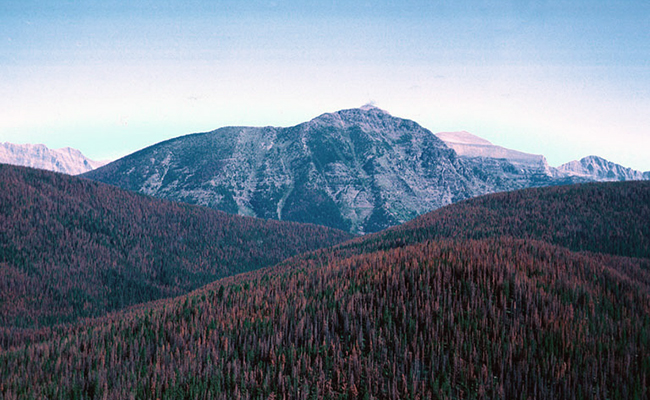FVS Models & Event Monitor Files
Lodgepole Mountain Pine Beetle Impact Model
The Lodgepole Mountain Pine Beetle Impact Model simulates Dendroctonus ponderosae Hopk.
Insect Description
Mountain Pine Beetle, Dendroctonus ponderosae(pdf)
Model Description
The Mountain Pine Beetle (MPB) Impact Model, an extension to the Forest Vegetation Simulator (FVS), simulates the lodgepole pine (Pinus contorta Dougl.) mortality impacts of mountain pine beetle (Dendroctonus ponderosae Hopk.). It is a single-stand model and does not recognize conditions or events that may be occurring in neighboring stands. There are two outbreak/epidemic simulation methods available in this model. The first method utilizes the MPB Rate of Loss model developed by Cole and McGregor (1983) and the second method utilizes the MPB Population Dynamics model developed by Burnell (1977).1
Mountain pine beetle epidemics can be initiated in the model manually with specific dates within the date range of the FVS simulation or randomly by comparing the value of a drawn random number and the probability of a local outbreak at each FVS cycle boundary. In the event that the inventory data set was collected while an outbreak was in progress, the pre-existing mortality can be used to initialize the model.
While mountain pine beetle is typically present in western forests where lodgepole pine is a significant component, the endemic level of the beetle is not addressed in this model: only epidemic situations. The model operates by assigning FVS tree records to size classes. If you are using the Rate of Loss model, the size classes are defined in two-inch increments. When using the Population Dynamics model, the user may specify the number of classes to which the lodgepole pine population will be distributed. Specific parameters are maintained for each size class and, during an outbreak, lodgepole pine survival rates for each class is determined. At the end of each FVS cycle (growth interval), mortality is then reported back to FVS for the individual tree records.
Documentation & Citations
1 Burnell, D.G. 1977. A dispersal-aggregation model for mountain pine beetle in lodgepole pine stands. Researches on Population Ecology. 19(1): 99-106.
Cole, Walter E.; McGregor, Mark D. 1983. Estimating the rate and amount of tree loss from mountain pine beetle infestations. Res. Pap. INT-318. Ogden, UT: U.S. Department of Agriculture, Forest Service, Intermountain Forest and Range Experiment Station. 22 p.
Crookston, Nicholas L.; Roelke, Robert C.; Burnell, Donald G.; Stage, Albert R. 1978. Evaluation of management alternatives for lodgepole pine stands using a stand projection model. In: Berryman, Alan A.; Amman, Gene D.; Stark, Ronald W., eds. Theory and practice of mountain pine beetle management in lodgepole pine forests: symposium held at Washington State University, Pullman, Washington, April 25-27, 1978. Moscow, ID: University of Idaho, Forest, Wildlife and Range Experiment Station: 114-122.
Keyword Guide
Lodgepole Mountain Pine Beetle Impact Model Keyword Guide (50 KB PDF)
Download

Aerial view of severe tree mortality in lodgepole pine. Photo by William M. Ciesla, Forest Health Management International.

